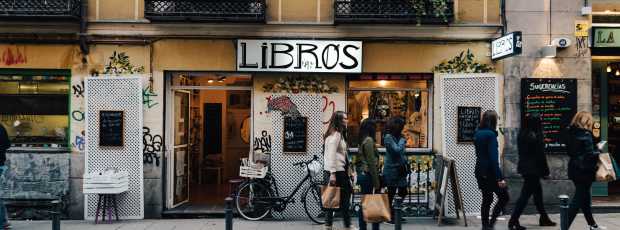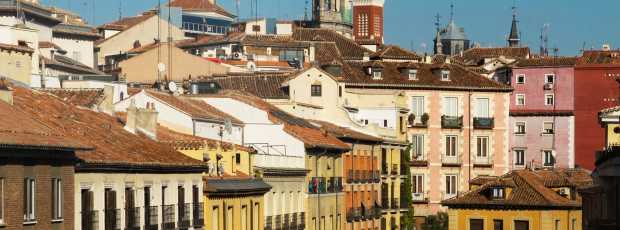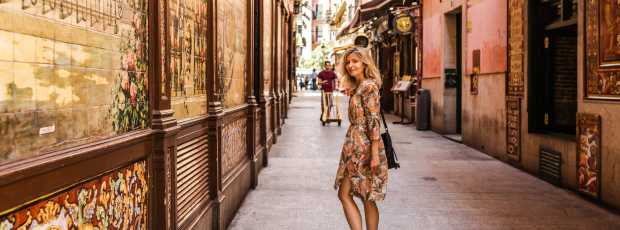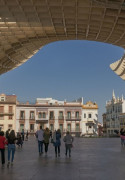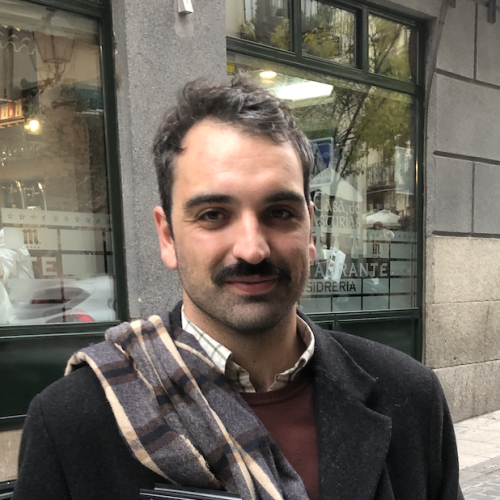Antonio was fantastic. We really enjoyed his inside knowledge of Madrid. He took the time to explain history and answer our questions.Joseph, Madrid, 2025
Table Of Contents
- The Four Barrios That Define This City
- Malasaña: Madrid's Counterculture in Motion
- La Latina: Where Sundays Start Slow and End Loud
- Chamberí: Elegant Architecture and Everyday Madrid
- Barrio de las Letras: Poets, Plaques, and Calle de las Huertas
- Retiro and Paseo del Prado: Where Green Space Meets Culture
- Where Madrid Is Still Figuring Itself Out
- Markets, Tapas, and Where to Eat Like You Live Here
- If You Need Quiet or Family-Friendly Spaces
- After Dark: Music, Dancing, and Terrace Sessions That Last Until Dawn
- Skip the Tourist Magnets: Here's Where to Go Instead
- Practical Tips for Moving Through Madrid Neighborhoods
- Frequently Asked Questions About Madrid Neighborhoods
- Madrid Doesn't Do Subtle, Neither Should You
Last Tuesday, I watched a German couple ask their hotel concierge for "authentic Madrid." He sent them to Plaza Mayor. I wanted to shake him. Authentic Madrid isn't a location you can pin on Google Maps; it's 11 PM on a Chamberí terrace when the waiter brings the bill without asking. It's the smell of churros mixing with cigarette smoke at dawn. It's knowing which metro stops to avoid during rush hour and which bartender pours vermouth like he's performing surgery.

Malasaña rooftops at golden hour with terrace crowds
This capital city doesn't reveal itself in monuments. Madrid is rhythm, argument, the specific way light hits sunny plazas on Sunday afternoons. I've lived here for 34 years. The best Madrid neighborhoods aren't the prettiest ones. They're where the city's pulse matches yours, where you can waste an entire afternoon and call it productivity.
The best Madrid experiences aren't on tour bus routes. Visiting Madrid means understanding that this modern metropolis runs on café con leche mornings, debates that stretch past midnight, and the collective agreement that 10 PM is an absolutely reasonable dinner hour.
The Four Barrios That Define This City
Start with four: Malasaña, Chamberí, La Latina, Letras. Malasaña is where Madrid's counterculture still shows its bones, bohemian vibe intact despite the vintage shops turning bougie. Chamberí is elegant architecture and old money. La Latina owns Sundays. Letras is literary history layered with wine bars and artistic spirit.
They're all within walking distance or a single metro ride. I can start my day with a cortado in Chamberí, hit the market by noon, and finish on a Malasaña rooftop terrace by sundown. Multiple metro lines connect most spots, but walking reveals more. These Madrid neighborhoods don't hide their personalities. Understanding each neighborhood's rhythm is key to visiting Madrid properly.
Looking for a private city experience in Madrid?
Explore the city with a local who plans a private day just for you; no groups, no scripts.
Malasaña: Madrid's Counterculture in Motion
This is my neighborhood, so yes, I'm biased. Malasaña is where punk roots refuse to die, where graffiti-covered walls on Calle Espíritu Santo get repainted every few months like the city's having an ongoing conversation with itself. Tiny bars line tiny streets. The plaza becomes a social experiment every weekend: art students, older couples who've lived here since La Movida, tourists photographing locals too busy talking to notice.
I moved here in my twenties for the music venues and cheap rent. The rent's no longer cheap. Some corners feel more Instagram than authentic, but the bones remain good. Bodega de la Ardosa on Calle Colón has been pouring vermouth since 1892. Chipped tiles, mixed crowd, and tortilla española thick enough to qualify as dinner. I go there when I need to remember what this great neighborhood was before it became a brand.

Plaza dos de Mayo packed with Sunday terrace crowds
Saturday afternoon at the plaza is pure theater. It fills with everyone from design students to a slightly older crowd nursing Friday hangovers. I grab a seat around 6 PM, order a caña, and watch the light change. That golden hour hits different here. Voices get louder. The crowd shifts. Suddenly, it's 11 PM, and you've made plans with three strangers.
For people watching, park yourself anywhere along the plaza's north side. First dates happen here. Breakup conversations. Someone's grandmother is meeting their new boyfriend. At least one person is crying into their phone.
La Latina: Where Sundays Start Slow and End Loud
This historic neighborhood owns Sunday mornings in Madrid. El Rastro kicks off around 10 AM, when the winding streets fill with leather jackets, vintage posters, and people haggling over ceramic jugs they don't need. I stopped buying years ago. Now I just move with the crowd, beer in hand, catching fragments of conversation in six languages.
By noon, the outdoor terraces around Plaza de la Paja are three-deep with people ordering vermouth like it's medicine. Ancient buildings line medieval city streets that survived wars and somehow still feel alive instead of museum-frozen. Cava Baja runs the full length. Wall-to-wall tapas bars. Half tourist traps, half legitimate.

Tapas terrace with string lights at dusk in La Latina
I go to Txirimiri on Calle Humilladero when I want pintxos that remind me why San Sebastián is overrated. They do txangurro (spider crab) on toast that's rich enough to ruin your appetite for three rounds, but you order it anyway because the texture is perfect. Tiny place. Always packed. No reservations. You wait, you eat standing, you leave happy.
The rhythm shifts as Sunday ages. Morning is families with strollers. Afternoon is friend groups claiming outdoor terraces. By evening, it's young professionals and anyone who forgot Monday exists. Walk from the plaza to Puerta del Sol, and you're there in about 15 minutes on foot.
Tree-lined streets, wrought-iron balconies, cozy cafés where the same regulars have been reading newspapers since 1987
Chamberí: Elegant Architecture and Everyday Madrid
Chamberí doesn't shout. Tree-lined streets, wrought-iron balconies, cozy cafés where the same regulars have been reading newspapers since 1987. This residential neighborhood feels like Madrid took a breath and decided elegance didn't require performance.
I come here when Malasaña gets too loud. Wide boulevards. Old-money apartment blocks. Green space tucked between buildings. Café Moderno on Calle Ponzano does a tostada with tomato that tastes like summer in February. Their cortado makes you sit there for an extra twenty minutes just thinking about nothing.

Small neighborhood park with benches under trees near Almagro
There's a tiny park near Calle Almagro where I go with a book when deadlines crush me. Just a square of grass and some benches. The light filters through the trees in this specific way that makes everything feel manageable. Older couples sit there in the mornings, not talking, just existing next to each other. That's the Chamberí rhythm: calm, consistent, unbothered. These are the hidden gems in Madrid that most visitors miss completely.
Barrio de las Letras: Poets, Plaques, and Calle de las Huertas
Madrid's literary heart, though it's more wine than words these days. This historic neighborhood sits between Puerta del Sol and Paseo del Prado. Streets literally paved with poetry. Walk Calle de las Huertas and look down. You'll see quotes from Lope de Vega, Cervantes, and every writer who drank their way through Madrid's Golden Age.
The Lope de Vega house museum is small. Twenty minutes if you read every plaque, but worth it for the courtyard. I took my mother there last spring, and she cried.

Art gallery entrance with exhibitions poster on Letras street La Fiambrera Gallery
By night, Huertas transforms into one long bar crawl. La Venencia on Calle Echegaray has been pouring sherry since 1929. They will judge you if you ask for a menu or try to pay with a card. Walls stained dark from decades of smoke, floor covered in discarded napkins (tradition), and ordering anything besides sherry feels like a personal insult. I love it. The manzanilla is bone-dry, but the atmosphere makes you feel in on something secret.
The best tapas bars are tucked on side streets where crowds thin. Avoid anywhere with someone trying to pull you inside.
Because No Two Travelers Are the Same
We help you shape a city day that matches your pace, your style, and your curiosity, not a fixed route.
Find out howRetiro and Paseo del Prado: Where Green Space Meets Culture
Retiro Park isn't just for tourists. Locals alike jog here at 7 AM, sketch by the lake when they should be working, and treat the lawns like living rooms on Sundays. This is Madrid's symbolic center, where the city remembers it needs oxygen.
Paseo del Prado connects the park to the museum mile: Prado Museum, Reina Sofía, Thyssen. The avenue is calmer on weekends and often pedestrian-friendly, filling with families on bikes. The Cibeles Fountain anchors the northern edge. Stunning in that way massive fountains are, but mostly it's just where we say "meet me at Cibeles."

Cibeles Fountain illuminated at dusk with traffic around it
I go here when I need space to think. The northwest corner near Puerta de Alcalá stays quieter. There's a small café by the rose garden where the coffee is decent, and the seating faces away from the main paths. This whole area represents some of the best things to do in Madrid that balance culture with actual breathing room.
Where Madrid Is Still Figuring Itself Out
These districts don't fit the postcard. They're messier, more interesting, and cheaper until everyone catches on. They're the Madrid neighborhoods where the city's future takes shape. Each neighborhood offers something different from the traditional barrios.
Lavapiés: Languages, Street Art, and the City's Future
Lavapiés is where Madrid gets interesting. This eclectic mix of cultures makes it the neighborhood everyone calls "authentic" until rent goes up. Indian restaurants line Calle Lavapiés, Bengali groceries next to Senegalese fabric shops, and the whole place hums with energy that feels like tomorrow.

Vibrant murals covering entire Lavapiés building walls
Tirso de Molina metro drops you at the edge. From there, it's wandering through one of Madrid's most dynamic neighborhoods. Vintage shops where everything smells like someone's grandmother's closet. Community theaters staging plays in three languages. Corner bars where the crowd is mixed. Street performances pop up on weekends, impromptu and always worth stopping for. I like Lavapiés for nights when I want the city to surprise me.
Conde Duque: Design Studios and Queer-Friendly Spaces
Conde Duque is quieter. More design studios than dive bars. Catching on with the trendy cafes crowd, queer-friendly spaces, and freelancers who camp out for eight hours. The cultural center hosts art exhibitions and summer concerts in the courtyard. I saw a flamenco-meets-electronic show there last July that shouldn't have worked but completely did.

Modern café interior with freelancers working in Conde Duque
Usera and Arganzuela: Still Under the Radar for Now
Usera has some of the best Chinese food in Madrid. Menus are mostly in Mandarin, where you just point at what the next table is eating. Arganzuela's industrial bones are filling with breweries and performance spaces. Give it two years, and everyone will claim they discovered it first.
Choose Your Barrio
With a City Unscripted host, you drift between barrios at your pace, swapping tourist checklists for terraces, tapas, and real neighborhood life.Markets, Tapas, and Where to Eat Like You Live Here
Madrid's food culture is neighborhood-specific. Each barrio has its rhythm, its specialties, its unspoken rules about when to show up. Exploring Madrid neighborhoods through food is one of the best ways to understand the city.
La Latina and the Market Question
Mercado de San Miguel is a tourist trap. But go at 10 AM, before crowds arrive, and it's manageable. I stop in maybe twice a year when showing someone around. It's not where locals eat here.

Mercado de San Miguel glass building exterior in morning light
For actual market culture, El Rastro on Sunday morning is half shopping, half social ritual. You're not really there to buy things (though I once bought a leather jacket for €8 that lasted three years). You're moving through the crowd with a beer, haggling over prices you'll never pay, running into people you haven't seen since last month.
Chueca: Tapas Without the Performance
Chueca is where I go for tapas bars after work. Compact, within walking distance from most Madrid neighborhoods. Spots don't waste time with menus that read like manifestos. Bar La Carmencita on Calle Libertad does classic Madrid cooking without trying to reinvent anything. Their rabo de toro (oxtail stew) is the kind of rich that makes you want to nap immediately after. It's one of the best tapas bars in the neighborhood.

Traditional tapas spread on bar counter in Chueca restaurant
Malasaña's Late-Night Food Scene
Malasaña's late-night food is legendary if you know the spots. After shows at Costello Club or Café La Palma, I usually end up at Pez Tortilla on Calle del Pez around 2 AM for tortilla española. They slice it thick, serve it barely warm. It tastes like the best decision you've made all night.

Late-night bar counter with thick tortilla española slice
If You Need Quiet or Family-Friendly Spaces
Some barrios prioritize calm over chaos. They're not boring, just operating at a different frequency. These Madrid neighborhoods offer a different side of the city.
Salamanca: Polished, Expensive, Unbothered
Salamanca is Madrid's upscale neighborhood, no qualifications needed. Designer stores and chic boutiques line Calle Serrano. Cafés serve perfectos cortados in silence. Everything feels too clean. Great if you want calm, less great if you want personality. The residential area around Diego de León is quiet enough for families who value sleep schedules over spontaneous 11 PM terrace sessions. For luxury shopping and beautiful architecture, this is the city's golden mile.

Luxury storefronts along tree-lined Calle Serrano shopping street
Moncloa and Argüelles: Functional Over Flashy
Moncloa and Argüelles are where students and young professionals overlap without friction. Safe. Affordable by Madrid standards. Connected by three metro lines that run on time. The vibe is functional rather than exciting, but these neighborhoods serve their purpose well for those living and working in the city.

Metro station entrance in residential Argüelles neighborhood
Where Chamberí Locals Gather for Everyday Life
Chamberí's small parks work as neighborhood meeting points. Older couples, parents with toddlers, people reading newspapers in the shade. The everyday Madrid that doesn't photograph well but makes the city livable.
Before You Go, Talk to Someone Who Knows
A local video call helps you plan the trip that’s right for you.
After Dark: Music, Dancing, and Terrace Sessions That Last Until Dawn
Madrid's nightlife isn't one thing. Indie gigs in Malasaña, inclusive dance floors in Chueca, terrace sessions that stretch from Sunday afternoon to Monday morning. Each Madrid neighborhood has its own after-dark personality.
Gran Vía and Malasaña: Theater and Indie Music
Gran Vía is theaters and bright lights, the main artery that tourists photograph, and locals use to cut across the city. I catch late films at Cine Callao sometimes.

Gran Vía at night with theater marquees and neon signs lit
Malasaña owns indie music. Venues like Ocho y Medio and Café La Palma pull crowds who care about setlists more than Instagram. Cheap drinks. Decent sound systems. By 1 AM, you'll recognize half the room.
Chueca: Inclusive Dance Floors and Zero Judgment
Chueca is inclusive and sweaty by midnight. The dance floors don't judge, which matters more than you'd think in a city that judges everything. LL Bar is where I go when I want good music and zero pretense. Mixed crowd. Unpredictable playlist. No one cares what you're wearing. This neighborhood has earned its reputation as one of Madrid's most welcoming spaces.

Neon bar sign reflecting on wet cobblestone at night
Outdoor Terrace Culture: The Sunday That Never Ends
Outdoor terraces blur Sunday into Monday. You claim a table around 2 PM, order steadily, and suddenly it's 9 PM, and you're still there. The etiquette is simple: hold your spot, keep ordering, and don't rush anyone.
Skip the Tourist Magnets: Here's Where to Go Instead
Some spots photograph well but eat poorly. Here's what to skip and where to redirect your energy when exploring Madrid neighborhoods.
Puerta del Sol and Plaza Mayor: Look, Don't Linger
These central plazas are fine for a five-minute photo stop. Do not eat there. The restaurants circling the square are expensive, mediocre, and designed for people who will never return. Walk five minutes to a better neighborhood and eat where we go.

Plaza Mayor arcades with tourists photographing the square
Gran Vía Shopping: All Chains, No Character
Shopping here is all international chains. If you want actual personality, head to tiny streets off nearby neighborhoods or the vintage shops in Malasaña, where at least the clothes have a past.
Royal Palace Area: Beautiful Building, Mediocre Meals
The Royal Palace is genuinely beautiful. The restaurants nearby are not. Visit early when it's quiet, then drift toward the Austrias lanes for lunch. Keep the architecture, skip the mediocre paella aimed at tour groups.
Practical Tips for Moving Through Madrid Neighborhoods
Metro stops, timing, budget cues, and the unspoken rules that make navigating this city easier. Understanding how Madrid neighborhoods connect makes all the difference. If you want to explore beyond the city center, consider day trips to nearby towns and landscapes.
Getting Around: Metro and Walking
- Metro coverage: In the center, you're rarely more than a ten-minute walk from a station, making it easy to hop between neighborhoods quickly.
- Walking between barrios: If you're staying within the best neighborhoods (Malasaña, Chamberí, Letras), walking works fine and often beats waiting for trains.
- Navigation tip: Each neighborhood flows into the next naturally. I walk most places because it's faster than you think, and you catch more of the city's rhythm.

Madrid metro map showing central Line 1 station connections
Timing and Budget: When to Go, What to Spend
- Sunday timing: The market belongs to Sunday morning. Slow coffee happens after. Terrace life kicks in by noon.
- Prime terrace hours: Thursday evenings are when Chamberí locals claim their spots. Get there by 7 PM if you want a table.
- Tourist trap test: Eat where you see Spanish families with kids running around. That's the tell.
- Menú del día: Locals eat this at lunch (three courses, wine included, usually €12-15). It's the best value in Madrid.
- High-end dining: Save expensive restaurants for birthdays, not Tuesdays.
- Tipping culture: Not mandatory, but rounding up or leaving a euro feels right, and locals do it.
Etiquette and Safety: The Unspoken Rules
- Terrace protocol: Sit down and wait for service. Don't hover at the bar unless it's explicitly standing-only.
- Queueing style: Polite but loose at crowded spots. Make eye contact with the bartender and wait your turn without being aggressive.
- Walking at night: Madrid is walkable after dark. Solo travelers are fine in most neighborhoods.
- Areas to avoid late: Skip Lavapiés' quieter corners after midnight if you're alone.
- Family-friendly zones: Chamberí, Salamanca, and areas near the park are consistently safe day and night.
Frequently Asked Questions About Madrid Neighborhoods
1) What is the nicest neighborhood in Madrid for first-timers?
Barrio de las Letras or Chamberí. Letras gives you historic charm and a central location. Chamberí is quieter but still walkable to everything.
2) Which areas are safest for solo travelers or families?
Chamberí, Salamanca, and the areas near Retiro. Well-lit, residential, and calm even late.
3) Where do expats or Americans tend to live in Madrid?
Chamberí and Salamanca for families. Malasaña and Chueca for younger expats who want nightlife.
4)What's the best neighborhood for nightlife and live music?
Malasaña for indie venues and late bars. Chueca for inclusive dance floors.
5) Where can I find the most authentic tapas bars without tourist traps?
Chueca and side streets near Letras. Avoid multilingual menus and anyone pulling you inside.
6) How far apart are the main barrios?
Malasaña to Chueca is about ten minutes on foot. Most Madrid neighborhoods connect easily by walking.
7) Which neighborhood has the most historic charm and beautiful architecture?
Barrio de las Letras for literary history, Chamberí for elegant architecture, and La Latina for medieval streets.
8) What's open on a Sunday in Madrid?
The market, all parks, most museums by 10 AM, and about half the restaurants. Shops are mostly closed.
9) How do locals describe their favorite barrio in one word?
Malasaña: alive. La Latina: loud. Chamberí: elegante. Chueca: free. Lavapiés: real. Salamanca: polished. Letras: layered.
Madrid Doesn't Do Subtle, Neither Should You
Here's what I tell people: this city doesn't do subtle, and neither should your travel style. The saying goes "De Madrid al cielo" (from Madrid to heaven), but it starts with the barrios. Every street teaches its own rhythm. The trick isn't following a map; it's following your energy level and hunger.

Madrid rooftops at sunset with Cibeles Fountain lit in distance
Want loud and messy? La Latina on Sunday. Need elegant and calm? Chamberí at dawn. Craving something that surprises you? Lavapiés at any hour. Walk more than you planned. Eat later than feels natural. Say yes to that third vermouth. That's what makes Spain experiences worth the trip.
See you on the terraces.
Keep Exploring Spain
Ready to Plan Your Perfect Day in Madrid?
Start your experienceWhat if Your Day in Madrid Was Planned by Someone Who Knows It — and You?
City Unscripted matches you with a local host who creates a private experience based on your interests, not a set route.
Learn more about usWant to Experience the Real Madrid With Someone Who Lives There?
A fully private experience, planned and led by a local host who tailors the day to you



